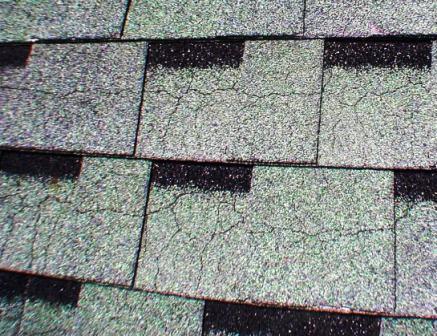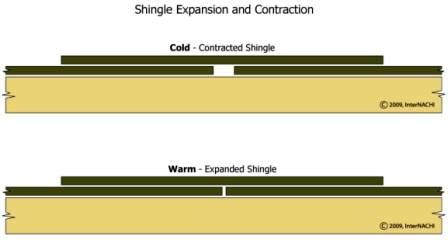Mastering Roof Inspections: Asphalt Composition Shingles, Part 39
by Kenton Shepard and Nick Gromicko, CMI®
Let's examine the differences between splitting and cracking, and identify the different causes of splitting and the visual clues that aid in its identification.
Splitting vs. Cracking

The difference between splitting and cracking is that a split goes entirely through a shingle…

…and a crack is limited to the surface of the asphalt layer.

Roof-Structure Assembly
A roof structure covered with asphalt shingles actually consists of two separate assemblies.
The first assembly is formed by the roof sheathing fastened to the roof framing members, such as rafters, roof trusses, ridges and blocking. Together, these components form a single assembly: the roof deck.
The second assembly is formed by the shingles that are bonded to each other by adhesive strips and which, structurally, may act as one big shingle if the adhesive bond is strong enough.
These components are all attached to each other, so why not call them one assembly?
There are two reasons:
1. They typically consist of materials that expand and contract at significantly different rates. Rafter sheathing and roof trusses are made of wood and will react in a manner similar to changes in moisture and temperature.
2. They have different functions. The rafters and sheathing are part of the building structure and, when properly built and maintained, have a much longer design life than the roof-covering material. Roof framing is not designed to withstand direct exposure to weather.
As the roof sheathing expands and contracts, it exerts forces on the shingles through the fasteners, stretching the shingles and compressing them. These conditions create stresses between the two assemblies that, if extreme enough, can result in shingle splitting or buckling.
Splitting Over Shingle Joints
Shingle splitting due to temperature-related expansion and contraction is called thermal splitting. Thermal splitting typically happens where shingles bridge the joints in the underlying layer of shingles.
There are no industry standards that specify the minimum bond strength of shingle adhesive strips. If the adhesive strips bond shingles together strongly enough, the shingles on a roof slope can act almost as a single membrane.

As shingles warm and expand, the joints between them become smaller. As shingles cool and shrink, the joints between them grow wider.
The shingles that bridge those underlying joints are shrinking, too, and these bridging shingles becoming increasingly stressed as the entire bonded-shingle assembly continues to shrink.
If this stress exceeds a critical point, one of two things will happen:
1. If the strength of the bond of the adhesive strips exceeds the tensile strength of the shingles, the shingles bridging the joints will split, creating an opportunity for leakage to develop.
2. If the tensile strength of the shingles surpasses the strength of the adhesive bonds, the bonds will fail, drastically lowering the wind resistance of the shingles.
Thermal splitting over joints between shingles may form a diagonal pattern up the roof following the stair-step pattern of the offset joints created during installation, or it may appear randomly above joints in different parts of the roof.
**************************************************
Learn how to master a roof inspection from beginning to end by reading the entire InterNACHI series: Mastering Roof Inspections.
Take InterNACHI’s free, online Roofing Inspection Course
Mastering Roof Inspections
Roofing Underlayment Types
Inspecting Underlayment on Roofs
Fall-Arrest Systems
Roofing (consumer-targeted)
More inspection articles like this


